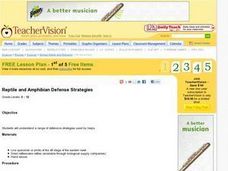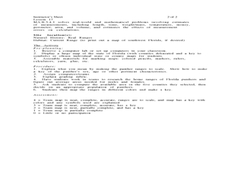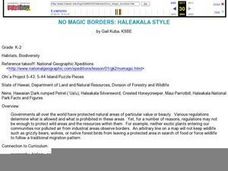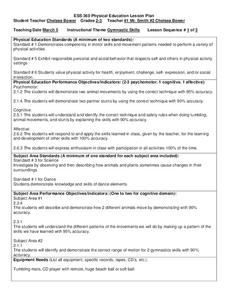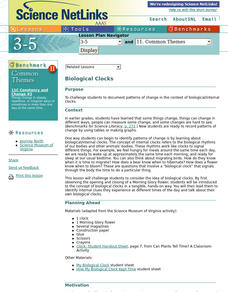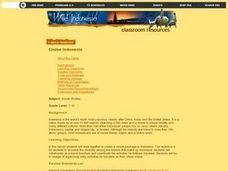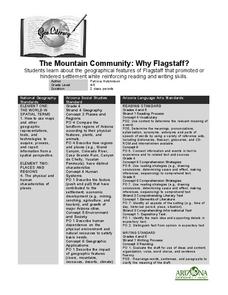Curated OER
"For the Birds" [part I]
Students identify birds that appear in Chinese and Japanese art, learning about
their physical characteristics, classifying them according to scientific principles, and exploring their habitats and migration patterns. This is part one...
Curated OER
SPLASH – Monitoring Humpback Whales
Students view a video about the humpback whale and why it is endangered. In this endangered species lesson, students recognize the importance of observing and following an endangered species in an ecosystem. Students identify the animals...
Curated OER
Cranes, Crosswalks, and Big Gulps
Students watch a video and answer questions based on wildlife jobs. In this wildlife lesson plan, students learn that biologists don't just play with animals but that there is a lot of study involved.
Curated OER
Ecology and the Conservation of Natural Resources
Pupils examine the habits of various organism and evaluate the need for conserving natural resources. They role-play as migrating birds traveling between habitats encountering hazards along the way. They observe animals in a terrarium...
Curated OER
Reptile and Amphibian Defense Strategies
Students study the stages of the Eastern newt either by collecting a live specimen or from pictures. They note the colors of the eft stage before reading the "Eastern Newt Species Account" that shows the newt's life stages, migration,...
Curated OER
California Biodiversity
Students examine several maps of California exhibiting features such as precipitation, topography, and vegetation. They look for patterns that might be the source of or influence biodiversity in different regions. They pay particular...
Curated OER
Desert Views - First Impressions: Travelers on the Gila Trail
Students draw animals and plants that are described to them as they read passages of people who traveled across the Gila Trail in the Southwest. In this Gila Trail lesson plan, students also write a letter describing a plant or animal in...
Curated OER
Can You Do It? I Can Do It!
Students imitate the same movements that different animals would make.
Curated OER
Mariposas
Students examine how animals use camouflage for survival. In this investigative lesson students define vocabulary words and see how it is the environment that controls which adaptations will help in survival.
Curated OER
Home on the Range
Young scholars use maps and mathematics to determine the appropriate panther population in a given area. In this Florida ecology lesson, students research the area requirements of male and female panther and use a map to help calculate...
Curated OER
No Magic Borders: Haleakala Style
Students discuss borders and boundaries. They discuss pollution and the fact that boundaries cannot stop pollution and that pollution affects even protected wildlife and plants. They participate in an activity in which they must place...
NOAA
A Laboratory Simulation of Ocean Surface Currents
Stimulate interest in ocean currents with a simulation. The first installment of a five-part middle school series teaches future oceanographers about the forces that interact to cause ocean currents. A simulation shows how wind and...
Curated OER
Butterflies
In this science and reading comprehension worksheet, students read a 1 page detailed passage about butterflies. Students then answer 7 questions.
Earth Day Network
The Neolithic Revolution
With the abundance of food products we can easily access in our society today, it is easy to forget the toll this can take on our global environment. Young learners will discover how the transition to agriculture and domesticated living...
Curated OER
Natural Selection
Kids act as scientists and preditors in this short natural selection activity; they collect and analyze data, then apply their new knowledge to real-world examples of natural selection. The layout of the worksheet is easy enough to use...
Curated OER
The Lesson: Species Under Threat
Students consider the plight of endangered species. In this global studies lesson, students research selected websites about endangered animals and identify global issues that contribute to their demise.
Curated OER
Magnetic Turtles
Students encounter how magnetic forces affect the navigation ability of sea turtle hatchings. Research is done to find out where the true magnetic North Pole lies. Exploration is discussed on how many things here on earth are affected by...
Curated OER
Gymnastic Skills
Students compete in a variety of games. In this gymnastic skills lesson plan, students play tag, participate in a challenge course, and practice gymnastics moves to increase physical fitness.
Curated OER
No magic borders
Middle schoolers discuss what they have heard about pollution. They explore the purposes and limitations of political boundaries and borders and identify some of the causes and effects of pollution.
Curated OER
Winter
Students explore the concept of hibernation. In this winter lesson, students read Time to Sleep by Denise Fleming and discuss the content of the story. Students participate in classroom activities that require them to develop their...
Curated OER
Water 1: Water and Ice
Students investigate water in its solid and liquid form. In this states of matter instructional activity, students experiment to see what happens as water goes from a solid, ice, to a liquid, water, and back again. They write about and...
Curated OER
Physical Education - Gallop
Students practice galloping. In this gross motor skills lesson, students review how to jump and hop using a jump-rope and hopscotch. The teacher shows the steps to gallop and they hold a noodle and pretend as if they are riding a...
Curated OER
Cruise Indonesia
Students work together to create a cruise package to Indonesia. They collaborate on a travel brochure and coordinate daily activities for fictitious travelers to discover the diversity among the islands that make up Indonesia.
Curated OER
The Mountain Community: Why Flagstaff?
Students identify geographical features that hindered or promoted settlement in the city of Flagstaff, Arizona. In this settlement lesson plan, students write a summary of what they learned and identify geographical features on a map.
!["For the Birds" [part I] Lesson Plan "For the Birds" [part I] Lesson Plan](http://content.lessonplanet.com/resources/thumbnails/122462/large/cgrmlwnvbnzlcnqymdeymtaxny0ynji5lwd4n2h5by5qcgc.jpg?1414222903)



